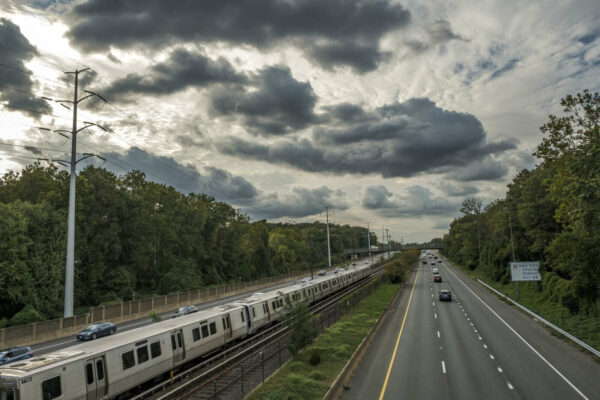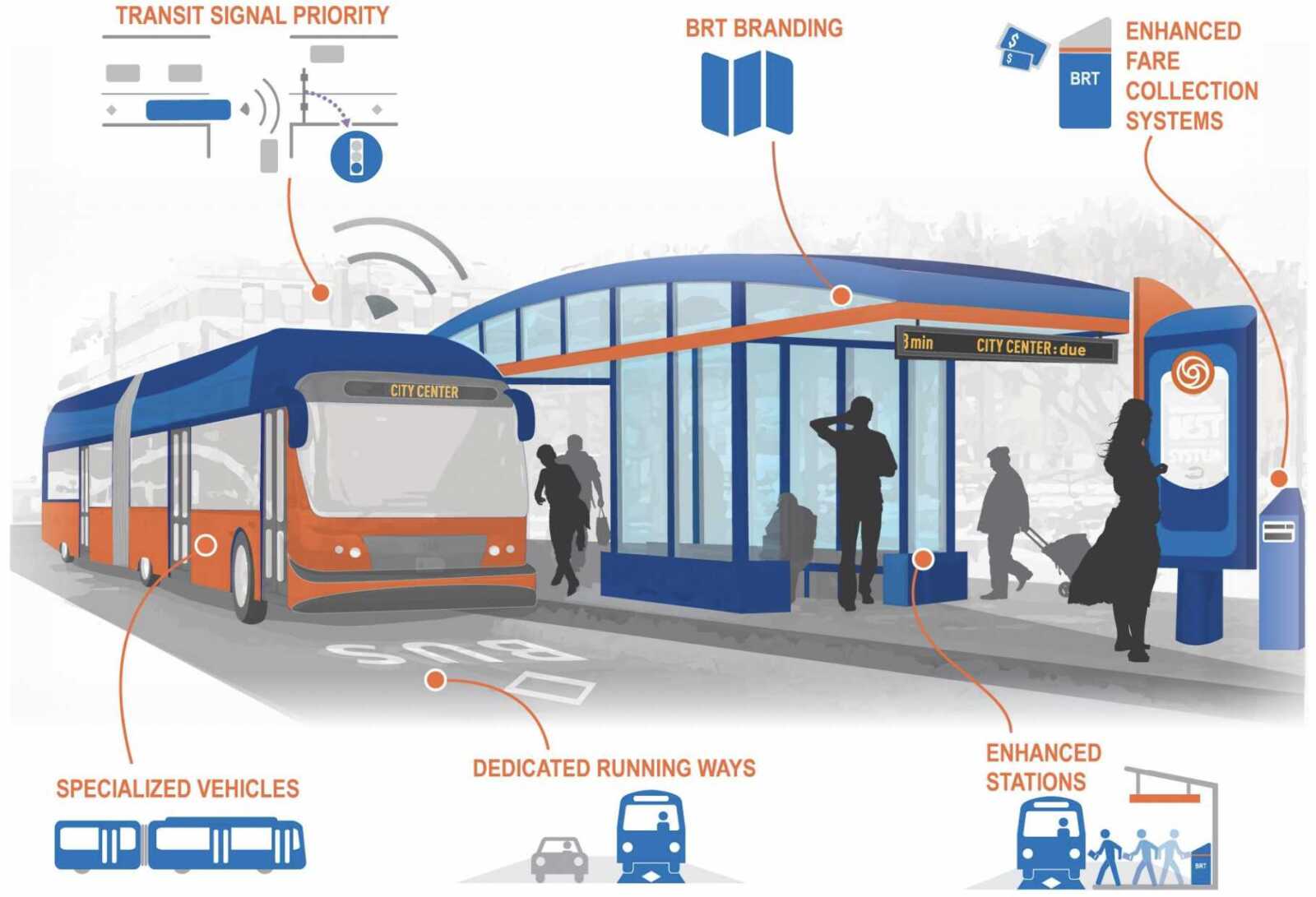
One day, a new bus rapid transit line could connect East Falls Church to Alexandria and Tysons Corner.
But the planning effort for the bus line, Envision Route 7, needs more studies and outreach, according to Northern Virginia Transportation Commission, or NVTC, which is leading the planning effort.
Although it received federal and state funding, NVTC appealed to the jurisdictions served by the bus line — including Arlington — for additional local funding to advance that work. This weekend, the Arlington County Board approved chipping in $70,000 over two years.
The bus rapid transit line would run between the Mark Center in Alexandria and the Spring Hill Metro station in Tysons, mostly making stops along Leesburg Pike in Bailey’s Crossroads and the City of Falls Church. Along the way, it will briefly pass through Arlington via the East Falls Church Metro station.
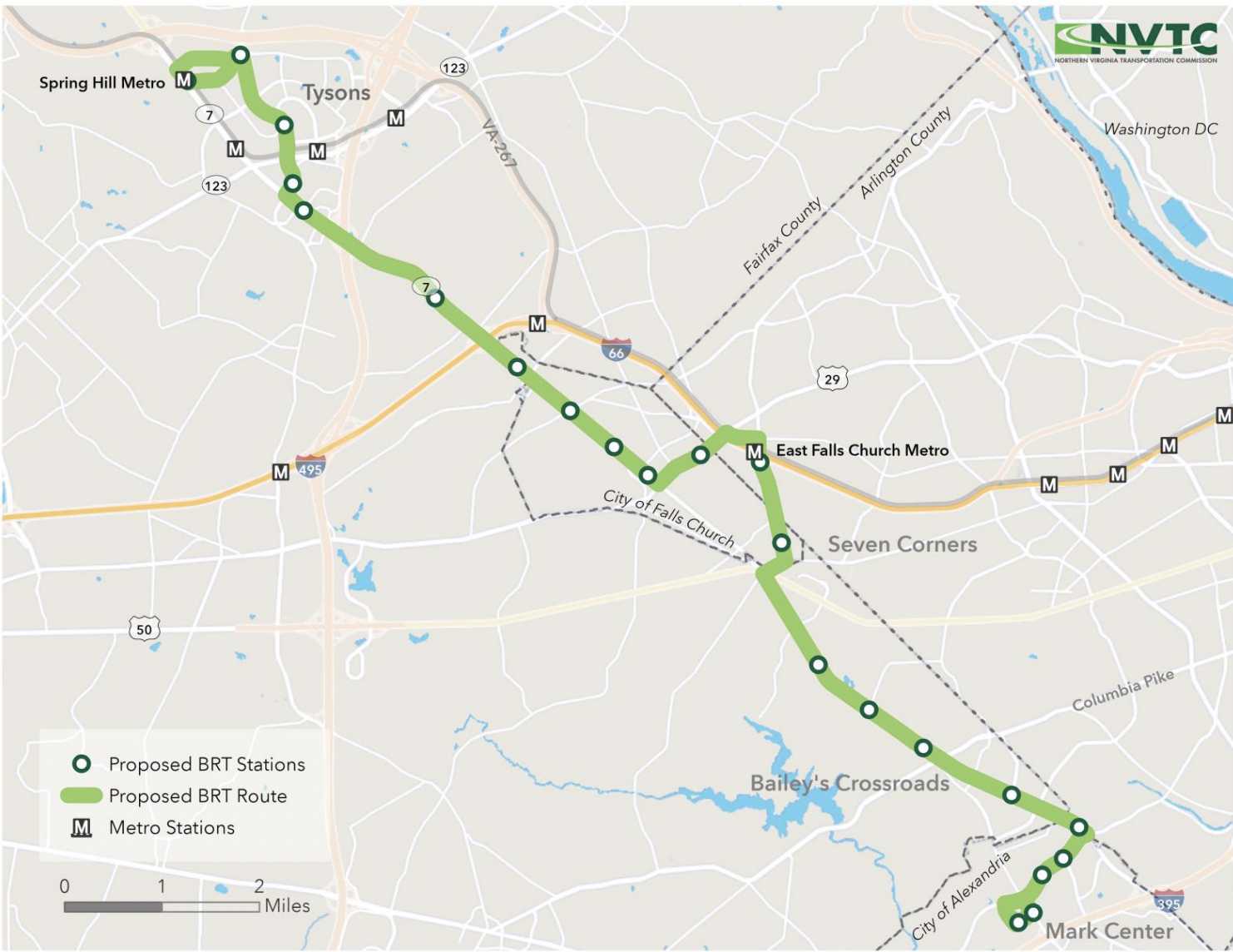
Envision Route 7 is now in its 10th year of planning and its fourth planning phase.
During this phase, NVTC will study traffic and environmental impacts and conduct extensive public outreach.
To do that work, it received $2 million in federal funds, requiring $500,000 in non-federal match. It then received $500,000 this fiscal year from the state Department of Rail and Public Transportation, requiring local match of $500,000.
Arlington previously contributed into earlier planning stages, which helped to decide on using bus rapid transit along the corridor.
Arlington County is applying for regional funding to run buses every six minutes between Fairfax County and Amazon’s second headquarters in Pentagon City during peak hours.
The Arlington County Board on Saturday authorized staff to apply for up to $8 million in Northern Virginia Transportation Commission funding. Funding would offset the operating costs associated with running 10 buses per hour during peak times for two years along a new Metrobus route dubbed the 16M, connecting the Skyline complex in the Bailey’s Crossroads area of Fairfax County down Columbia Pike, to Pentagon City and Crystal City.
The report suggests that the county is preparing for an increase in ridership after the opening of the first phase of Amazon’s HQ2, despite work from home trends.
“The 16M service will provide a direct connection to Amazon HQ2 with its first phase of construction (2.1 million square feet of commercial space) coming on-line in Summer/Fall 2023,” per a county report. “This service will also take advantage of the recently built portions of Columbia Pike and [eight] new transit stations located on Columbia Pike.”
But recommendations to increase frequency along this route date back well beyond Amazon’s decision to move into Arlington, says Dept. of Environmental Services spokeswoman Claudia Pors.
She says the request acts on a 2016 study, which “recommended creating a route connecting Skyline with Crystal City through Columbia Pike in anticipation of growth in Crystal City.” That followed the cancellation of the Columbia Pike streetcar project, which would have followed largely the same route.
“The study evaluated ridership forecasting, current service patterns, like bus and seat availability, and travel patterns, like trip lengths, ridership rates and traffic volume in the area to make the recommendation to increase frequency,” Pors said.
Sometime this spring, the new 16M route will begin revenue service with a base frequency of buses every 12 minutes during the service day. The new route will replace existing 16G/H service.
Pors said the average weekday ridership for the last four-and-a-half years along the 16G/H line peaked at a little over 4,500 average weekday riders before Covid, and is now about 60% recovered compared to pre-pandemic levels.
Ground was officially broken yesterday morning on the first phase of the $29 million extension of the Crystal City-Potomac Yard Transitway.
At a brief ceremony on Monday (May 9) near the site of a future Crystal City bus station, at the intersection of 12th Street S. and Long Bridge Drive, local officials gathered for remarks and photos with golden shovels to christen the first phase of the long-planned transit project.
“The transit way extension is really important because it is going to support the increase in regional travel demand in Pentagon City, Crystal City, and our partners in Potomac Yard,” said County Board Chair Katie Cristol during the ceremony. “As they continue to boom with the arrival of new businesses.”
Just last week, aerospace company Boeing announced it was moving its corporate headquarters to its existing Crystal City office — a short distance from where the groundbreaking was taking place.
The planned Pentagon City extension will add just over a mile to the 4.5-mile rapid bus transit corridor, eventually to connecting Amazon HQ2 and the Pentagon City Metro station. The Transitway will include center-running transit-only lanes cutting through 12th Street.
The first phase is expected to take about a year to finish, with an estimated April 2023 completion date. The work over the next 12 months will include the installation of two new transit stations at Crystal Drive and 15th Street S. and at 12th Street S. and Long Bridge Drive.
Locals will also see streetscape improvements along 12th Street S. between S. Eads Street and S. Clark Street, as well as the intersection of 12th Street S. and Crystal Drive. Some existing street parking along the route will become part of the dedicated bus lane.
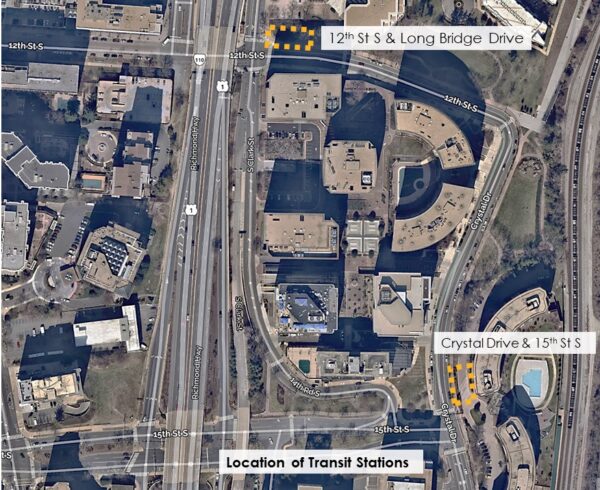
Surveying work started last month with actual construction expected to start in June, a county spokesperson told ARLnow. Street parking will be limited in some of those areas when construction begins, but residents will be notified prior.
The Transitway is dedicated infrastructure for the Metroway rapid bus transit line. It first debuted in 2014 and was hailed for being the first of its kind in the region. While it has achieved some of its initial goals, a lack of ridership, planned features not yet implemented, and confused motorists sometimes driving the wrong way in bus-only lanes have been ongoing challenges.
The Northern Virginia Transportation Authority (NVTA) is contributing most of the funds needed for the extension, including $19 million to the first phase alone.
Despite recent significant shifts in commuter patterns due to the pandemic, NVTA chair Phyllis Randall says the project remains a necessity and a good investment.
“I believe in the scope and I believe in the extension,” said Randall, who is also the Loudoun County Board Chair. “We know that people are going to keep moving to Northern Virginia… for jobs, for schools, for so many reasons. We need these transit options because people are coming here. I don’t think the need is diminished at all.”
Boeing’s increased presence in the neighborhood was noted several times in the ceremony as further proof that this extension is needed.
While it may not result in many new jobs, Cristol said the corporate giant’s decision shows that the county’s efforts in becoming more business-friendly are working.
“Arlington has spent a lot of time during my tenure on the [County] Board to reoriented ourselves to be more business friendly, to be more creative, to be more flexible, and to build better relationships with our commercial tenants. So, it feels like validation,” she told ARLnow.
Work is kicking off this week on an extension to the Crystal City-Potomac Yard transitway.
The project will eventually extend a dedicated corridor for rapid bus transit to Amazon’s HQ2 and the Pentagon City Metro station. Construction is now getting underway on the first segment of the extension.
The work will include the installation of two new transit stations at Crystal Drive and 15th Street S. and 12th Street S. and Long Bridge Drive, as well as street improvements along 12th Street S. stretching from Crystal City to Pentagon City.
Construction is expected to take a year, according to the county, and should be completed in April 2023.
The Transitway extension to Pentagon City will add more than a mile to the existing 4.5 mile corridor, including center-running transit-only lanes cutting through 12th Street.
The two new transit stations that will be built over the next year are among four others that are scheduled for construction. The stations will be similar in appearance to the existing Transitway stations on Crystal Drive and Clark Street.

Impact on commuters is supposed to be minimal, with work taking place Monday through Friday from 9 a.m. to 4 p.m. Portions of the northbound curbside lane along Crystal Drive, between 12th Street S. and 15th Street S. and up to Long Bridge Drive, will be inaccessible due to it being used as a construction staging area.
Existing street parking on that side of Crystal Drive will eventually become a transit-only lane, though the county has not given an exact timetable for when that might happen.
The street improvements will focus on the stretch of 12th Street S. from S. Eads Street to S. Clark Street in Crystal City and the intersection of 12th Street S. at Crystal Drive.
The work will include sidewalks, streetlights, pedestrian ramps, and new crosswalks at Army Navy Drive. There will also be a two-way bicycle facility under the Route 1 overpass, the first step in linking a planned bike track extending from Army Navy Drive to a multi-use path along S. Bell Street that will eventually go to the Crystal City Metro station. The design phase for that is nearly complete, with construction coming potentially this year.
The Transitway is the dedicated infrastructure for the Metroway rapid bus transit line that debuted in 2014. It was the first of its kind in the region and hailed as a public transportation achievement.
The transit line was designed to provide covered stations, more frequent service and newer buses, driving along a route connecting Arlington and Alexandria. The $42 million price tag was split evenly between Arlington and Alexandria.
While intended to boost bus ridership and provide accessibility to neighborhoods that are rapidly developing, the line has achieved only some of those goals and has been plagued by lack of riders. Additionally, planned features like off-board fare collection have not yet been implemented, and confused motorists sometimes drive the wrong way in the bus-only lanes.
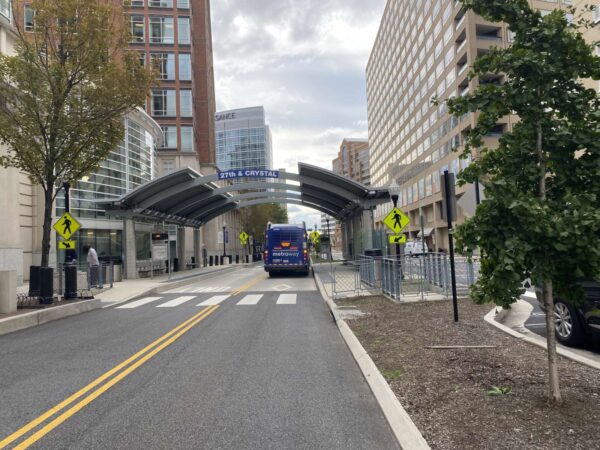
Many are predicting that the pandemic will drastically affect how we commute and use public transportation for the foreseeable future.
How that will impact long-term transportation projects, like the Metroway bus rapid transit line and the Crystal City-Potomac Yard Transitway extension to Pentagon City, is a puzzle that local officials are trying to put together.
In 2021, according to Metro’s data, bus ridership overall is down by close to two thirds from 2019. And those numbers may not increase a whole lot for at least a couple of years.
“It really is something that we all are literally struggling with to understand,” Arlington County’s Transit Bureau Chief Lynn Rivers told ARLnow. The transit bureau was responsible for building out the initial Transitway infrastructure, as well as the forthcoming Pentagon City extension. “Now… we’re talking 2023 when we’re going to start seeing the same levels [of bus riderships] that we had before.”
Even as more people head back to the office and lockdowns are no longer in effect, traffic patterns have shifted particularly on the roads. There’s now less traffic in the mornings, allowing cars and buses to get to their destination quicker.
“People are changing their patterns and how they are using the service,” Rivers said. “The huge rush hours in the morning and in the afternoon, we may not see that.”
Instead of seeing huge jumps in use during peak times — 6-9 a.m. in the morning and 3-7 p.m. in the evening — Rivers said there may be a leveling-out of how commuters use train and bus transit.
“Throughout the day, there will be constant movement,” she said.
This shift could be at least somewhat permanent and largely due to still a large number of folks continuing to work from home. Those that are going to the office, meanwhile, are spending fewer hours there.
(Nearly half of readers who responded to a ARLnow morning poll in October said they were still working from home.)
In response, and to encourage more people to use the bus system, Metro increased the frequency of the Metroway back in Sep last month (as well as other bus lines). It now runs every 12 minutes on weekdays and 20 minutes on weekends from 7 a.m. to 9 p.m., in a bid to encourage ridership.
This shift in commuting patterns comes just as the county unveiled design plans last months for Pentagon City extension of the Transitway. While it comes with a price tag of nearly $28 million, most of the cost will be financed by the state and the Northern Virginia Transportation Authority. Arlington is contributing about $1.8 million to the project, according to county officials.
Nonetheless, that’s still a significant use of tax dollars at a time when commuting is down and there are plenty of competing priorities. When the rapid bus transit system in Arlington was first conceived more than a decade ago, an airborne illness was not infecting millions across the globe.
With the knowledge that Covid spreads more easily in indoor settings, there could be hesitation among some commuters to be in crowded spaces with strangers despite relatively high local vaccination rates.
“Are we really going to cram back on a bus?” Chris Slatt, Arlington Transportation Commission chair and founder of Sustainable Mobility for Arlington County, asks rhetorically. “Are we going to want to be crowded into a Metro train as we were two or three years ago?”
John Vihstadt, former County Board member who vehemently opposed the Columbia Pike streetcar project, which he helped to scuttle, agrees that shifting commuter behaviors could make the Transitway not as a sound an investment as it once appeared.
While an avid public transit user himself and, generally, in favor of bus rapid transit — opponents of the streetcar argued that BRT along the Pike was a cost-effective alternative to a light rail system — Vihstadt thinks the county needs to do more modeling and forecasting of people’s commuting patterns before moving ahead with the build out.
“We can’t stick our heads in the sand and just expect that everything is going to ultimately return to the status quo,” he tells ARLnow.
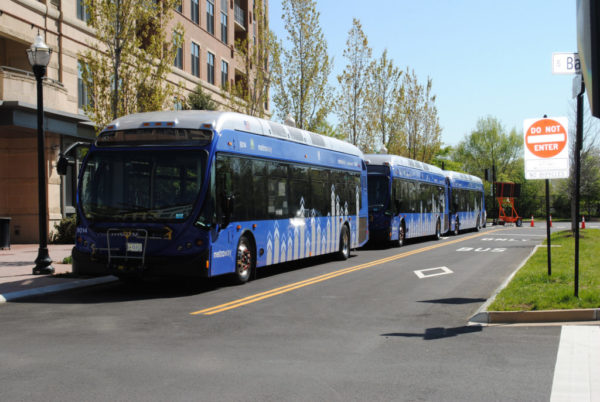
A decade ago, when Arlington County was in the midst of planning the Crystal City Potomac Yard Transitway for the future Metroway bus rapid transit line, the Route 1 corridor looked a lot different.
Development was still ongoing in the corridor, which encompasses Pentagon City and Crystal City, and Amazon was still years away from selecting the area for its HQ2.
There were just over 17,000 residents in the corridor and nearly three quarters of them lived in rental units, according to 2010 county census data. By 2020, that number had risen by about 15% to 20,000 residents. Renters now occupy 91% of the housing stock, according to county data.
Arlington’s section of the Crystal City Potomac Yard Transitway opened in 2016 with the Pentagon City extension aiming for a 2023 opening.
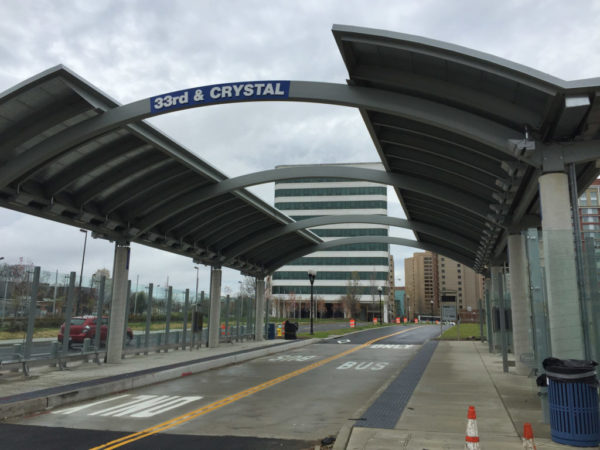
While there have been plenty of bumps along the road, including the continued delay of the Potomac Yard Metro station and low ridership during the pandemic, at least one transportation advocate praises the county for looking ahead.
“To do this later, after the development happens, would have been 20 times harder. 100 times harder,” Chris Slatt, Arlington Transportation Commission chair and founder of Sustainable Mobility for Arlington, told ARLnow. “I really give Arlington a lot of credit.”
In terms of Potomac Yard, Slatt made the point that this was an extremely rare opportunity where urban and transportation planners had the ability to start anew and could try out their best laid plans without dealing with already existing infrastructure.
“Potomac Yard was this kind of special opportunity that we don’t have very often,” said Slatt. “I’m sure there are a lot of other places in Northern Virginia where we can say we’re basically a new neighborhood from scratch.”
Local officials agree, which is why the Metroway is such an exciting project for them.
“For mass transit planners… it is a lot easier to design the infrastructure when you’re starting from scratch rather than trying to retrofit it into a pre-existing system, particularly if you want dedicated [transit] lanes,” said Eric Randall, principal transportation engineer with the Metropolitan Washington Council of Governments (MWCOG).
Plus, he noted, it’s easier for residents to get in the “frame of mind” to use the mass transit option if it is there initially, as opposed to needing to break their previous habits.
Even as officials and advocates continue to hail the Crystal City-Potomac Yard Transitway as forward-thinking, there’ve been literal instances of backwards driving.
ARLnow has received reports of cars entering the Transitway’s bus lanes, often even driving the wrong direction in the lanes, which parallel Crystal Drive for about a mile. It seems to mostly stem from confusion over the roadway configuration.
Mark Stack lives in the Concord Crystal City apartments, directly across from a Transitway bus station at 27th Street S. and Crystal Drive. From the high-rise building he can see cars in the lanes that are intended only for Metroway buses.
“Just today, [there was] one car on the wrong side of the road and two other vehicles traveling down the bus lane,” he told ARLnow. “It’s a daily, hourly occurrence. It’s not like once or twice. It happens pretty often.”
Walking in his neighborhood, Stack has also seen cars entering the lanes near the bus stops located 33rd Street S. and 26th Street S. along Crystal Drive. He’s fearful that drivers going the wrong direction will hit buses head-on or kids bicycling, which he also sees often in the lanes (which, technically, is also not allowed).
“I’m just surprised there’s never been any accidents,” Stack said. “It’s a miracle.”
ARLnow also checked out several of the intersections and Transitway bus stops that Stack spoke about. While no unauthorized vehicles were observed in the lanes at the time, it’s evident confusion could be possible, particularly at night.
There are right and left turn lanes leading directly into the bus lanes, as well as dark red markings that may not be clearly visible at night. There are, however, “do not enter” signs and medians that do prevent mingling of traffic.
Darren Buck, a member of Arlington County’s Transportation Commission, also has seen unauthorized cars going into the dedicated bus lanes. While the danger does concern him, he additionally worries that drivers are intentionally entering them to bypass traffic
“If that’s the case, the success of the Transitway is at risk,” he says, since one of the major selling points of rapid bus transit is that it removes buses from car traffic. “[There] probably needs to be a broader conversation about enforcement in bus-exclusive facilities.”
The county acknowledges that unauthorized vehicles using the bus lanes, intentionally or not, is an ongoing issue that dates back to the Transitway’s opening.
“[Arlington Department of Environmental Services] staff have been made aware of issues with operations on the Crystal City – Potomac Yard Transitway, specifically regarding private vehicles using and misusing the dedicated transit lanes in 2016,” DES spokesperson Nathan Graham wrote in an email to ARLnow. He noted that they have received reports of this happening recently.
In response, transportation staff earlier this year applied red pavement markings to highlight the bus-only lanes at several of the Transitway segments, Graham said, including at 27th Street S. and Potomac Avenue, 33rd Street S. and Crystal Drive, and 26th Street S. and Crystal Drive.
“Moving forward, we will enhance this practice of clearly denoting entry points for bus-only lanes and at areas where there are reports of driver confusion with additional paint and signage, as appropriate,” wrote Graham. “We will also reach out to our colleagues at ACPD to review options for enforcement at these locations.”
All of these are issues that the county will keep in mind as the build-out for the extension to Pentagon City begins next year.
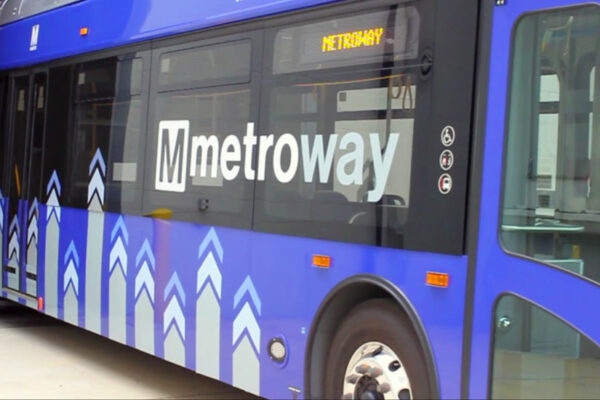
When Metroway, the region’s first rapid bus transit line, launched in 2014 it was hailed as the future.
Dedicated lanes, more frequent service, covered stations, and bigger, newer buses along a 4.5-mile route connecting Arlington and Alexandria would boost bus ridership in sections of both jurisdictions that were rapidly developing.
The price tag was big — more than $42 million, split nearly evenly between Arlington and Alexandria — but officials believed it was worth it and could have the added benefit of revving up rapid bus transit elsewhere in the D.C. area.
“A lot of people will be looking to this project as a test concept to find out what lessons they can learn from it,” said Eric Randall, a senior transportation engineer at the Metropolitan Washington Council of Governments (MWCOG), at the time. “It offers us an opportunity to apply some concepts for the first time — things like off-board fare collection, a design of bus stops with higher platforms and custom design shelters, a new branding and frequency of buses.”
It’s now 2021, seven years since Metroway’s launch, and it seems like a good time to ask the question: what have we learned from Metroway, the region’s first rapid bus transit?
Despite less-than-stellar ridership numbers and outside factors, rapid bus transit with dedicated infrastructure remains a worthy investment, according to local officials and public transportation advocates.
“I live in Alexandria and take Metroway monthly, from my perspective as a user, I think it’s a success,” Randall told ARLnow earlier this fall. He remains a transportation engineer with MWCOG.
“[Metroway] is doing what it’s supposed to be doing,” said Lynn Rivers, Arlington County’s Transit Bureau Chief. “Which is getting people out of their cars and onto the transit lanes.”
“Metroway is great,” said Sustainable Mobility for Arlington founder and Arlington Transportation Commission chair Chris Slatt . “It’s fantastic to have an example in Arlington of a dedicated space for transit. We really want to make transit time competitive with other ways to get around… and I think it does that.”
What’s more, the county is investing further into the needed infrastructure. In September, the county unveiled designs to extend the Transitway by an additional five stations and 1.1 miles so that it connects with the Pentagon City Metro station (not to mention areas close to Amazon’s new HQ2). While some advocates expressed their frustration about the lack of community engagement on street designs, their complaints were not necessarily about the concept of rapid bus transit or Metroway.
The extension is costing nearly $28 million, though most of it will be financed by the state and the Northern Virginia Transportation Authority. Arlington itself is spending about $1.8 million, according to Rivers, which is only about 6% of the project’s total cost.
Construction on the first segment is expected to start in the winter of 2022 with completion in late 2023.
That’s not to say there haven’t been challenges. Off-board fare collection, even though it was promised, has not been implemented yet. There’ve been sightings of confused motorists, as reported by ARLnow readers, driving their cars the wrong way in the dedicated bus lanes, despites signs and marked roads. Ridership hasn’t been as high as perhaps expected, leading to 2016 reports that shutting it down was being considered.
For that, the lack of steady progress in terms of development at Potomac Yard and issues with opening the Metro station there are being blamed.
“Certain forecasts way back when were perhaps based on more optimistic assumptions in terms of development [in Potomac Yard],” admitted Randall.
Running Store Coming to Pentagon City — “Federal Realty Investment Trust has leased the last bit of vacant retail space at Westpost, the 14-acre mixed-use development a short walk from where Amazon.com Inc.’s new headquarters buildings will stand. The leases put the roughly 297,000-square-foot retail center on course to be fully occupied in the first half of 2022 after a handful of notable vacancies, including the nearly 34,000-square-foot former Bed, Bath & Beyond to be replaced by a Target store, and the roughly 4,500-square-foot space where Road Runner Sports will replace a shuttered Unleashed by Petco.” [Washington Business Journal]
Library Seeking Latino History Donations — “Over the last three decades, Arlington’s Latino community has rapidly grown and stockpiled a wealth of history. And this week, librarians and historians at the Center for Local History at Arlington Public Library are asking for donations of documents to archive the county’s Hispanic history. The project is called Re-Encuentro de Arlington Latinos.” [WTOP]
Rock Climbing Gym Goes Green — “Earth Treks Crystal City prides itself as a rock climbing outlet for people living in a metropolitan area and the business in northern Virginia hopes its roots in rock climbing can bring forward better environmental practices… Earth Treks announced recently its partnership with a Virginia company that allows its climbers to bring in old and rundown equipment — shoes, water bottles and harnesses — which will be reused in a variety of ways, including to make dog harnesses.” [WUSA 9]
Synetic Returns to Theater — “Last night night found me in Crystal City, where Synetic Theater was back in its performance venue for the first time since the pandemic, staging a production of ‘The Madness of Poe…’ Performers were not masked, a nice change after recent experiences with a number of troupes who use Arlington Public Schools facilities and are not allowed to let their actors, though all vaccinated, go without masks.” [Sun Gazette]
New Commuter Bus Service Funded — “The Northern Virginia Transportation Commission plans to fund a new express bus service, part of efforts aimed at reducing congestion connected with Interstate 66 and the Beltway. The commission approved a plan yesterday to fund the bus service with over $5.1 million for two years. Routes would run from the Reston South Park and Ride lot to key destinations in Arlington County that include the Pentagon, Pentagon City and Crystal City.” [Reston Now]
More Studies for Route 7 Bus Route — “A regional study of the proposed bus rapid transit (BRT) route from Tysons to Alexandria is moving into a new phase that will assess options through the Seven Corners area. The Northern Virginia Transportation Commission voted last night (Thursday) to approve a contract for the fourth phase of its Envision Route 7 mobility analysis study.” The bus might also make a stop at the East Falls Church Metro station in Arlington. [Tysons Reporter]
It looks like the Washington Metropolitan Area Transit Authority is not going to consider a Metro line through Columbia Pike any time soon.
For the last year and a half, there were some signs that such an expansion — which was part of initial Metro planning in the 1960s but was never built — was an actual possibility.
In December 2019, Metro mulled the idea for a Silver Line extension down Columbia Pike and up Route 7, connecting with the West Falls Church Station, as one of a handful of ways to address congestion in the Rosslyn Metro tunnel, system reliability and future ridership growth. News of President Biden’s $2 trillion infrastructure plan, which coincided with WMATA’s deliberations, further crystallized those hopes.
A new study posted this week, however, indicates this extension — which nearly 70% of ARLnow readers supported in an April poll — has been ruled out. That follows a cost-benefit analysis by planners, which favored four other routes — each starting with a second Metro station in Rosslyn and adding an underground Metro station in Georgetown — as well as two options that don’t involve new construction.
Pretty much all of these (admittedly far-off) scenarios call for Metro to finally pass through Georgetown…and you may recall that the city could soon buy a very prominent Key Bridge site for a station there: https://t.co/E1DaxMAn1e https://t.co/Lp0OhMsHGX
— Alex Koma (@AlexKomaWBJ) September 7, 2021
WMATA is looking for the next way to expand Metro on a scale similar to the Silver Line extension to Dulles International Airport, as it seeks to alleviate traffic and congestion in the Rosslyn tunnel and along the the Blue, Orange and Silver lines. In early 2019, it launched the Blue/Orange/Silver Capacity & Reliability Study (BOS Study) to identify a line that would do so.
Metro planners outlined the four finalists, absent the Pike, in an update to the BOS Study that Metro posted this week. The four options use a second Rosslyn station to alleviate congestion at the existing station, and establish a long-discussed underground station in Georgetown, which has never had a Metro connection.
The possible projects, which would cost billions of dollars to build, include a Blue Line loop to National Harbor — which planners think would add the most new riders and revenue to the Metro system — as well as a Blue Line extension to Greenbelt, a Silver Line express tunnel option through Arlington, and a Silver Line to New Carrollton.
The express option “would create a separate tunnel and tracks for the Silver Line, starting at West Falls Church Station,” according to WMATA. A diagram suggests it would skip all Arlington stations except the second Rosslyn station and perhaps a second Ballston station.
“From WFC to a new second Rosslyn station, the new tunnel could support express service, local service or a mix of express and local service,” WMATA said. “From the second Rosslyn station, the Silver Line would travel through Georgetown…. to Greenbelt.”
A mobility advocacy group is asking the county to build a three-year plan for funding projects that make non-car transit faster, more desirable and safer.
And the group, Sustainable Mobility, is trying to capitalize on signs that people are interested in bicycling and walking more coming out of the pandemic.
“We have to seize that opportunity before everybody gets into their cars again,” said Chris Slatt, the group’s president, who is also chair of the Transportation Commission and an opinion columnist on ARLnow. “This is an inflection point. Arlington has let too many opportunities pass during COVID-19 — we never achieved open streets, when people demanded more space to walk, sit and eat — we need them to do better now.”
Its recommendations respond to a draft document outlining the large projects that Arlington County intends to embark on over the next three years. This plan, called the Capital Improvement Plan, is winding its way through review processes and is set to be approved by the County Board in July.
Volunteers from Sustainable Mobility, or SusMo, combed through the transportation projects and identified a handful to nix, postpone or kick to developers for funding and implementation, which they say could free up about $17 million that could fund 20 projects or programs.
The alternative projects fall into five of SusMo’s priority areas:
- Funding Vision Zero
- Speeding up transit
- Building safe routes to every school
- Building out the bike network for all ages and abilities
- Expanding and connecting the trail network
“None of what’s in our plan is really our idea,” Slatt said. “It is all things that are in sector plans, projects that… the county already has [identified], projects that were identified in the bicycle element of the Master Transportation Plan, or just ways to fund priorities that Arlington says they already have.”
Highlights include:
- Changing the signals to reduce the time buses spend at intersections
- Completing the Arlington Blvd Trail
- Conducting a feasibility study of dedicated transit and high-occupancy vehicle lanes on Columbia Pike
- All-door bus boarding and off-vehicle fare collection, to speed up buses
- A trail on the west side of Carlin Springs road, with a connection to the W&OD Trail, to provide a safer route to Kenmore Middle School
- Protected bike lanes on S. George Mason Drive between Route 7 and Route 50, providing a safe connection to Wakefield High School
- Additional capital funding for other Safe Routes to School projects
- Protected bike lanes on a portion of N. Highland Street in Clarendon
- A two-way protected bike lane on Fairfax Drive between Ballston and Clarendon
- Other “neighborhood bikeways”
Some projects are already in the County Manager’s draft Capital Improvement Program proposal, including a feasibility study for a trail underpass under Shirlington Road near the Weenie Beenie, and a new trail along the Arlington National Cemetery wall between Columbia Pike and Memorial Avenue.


